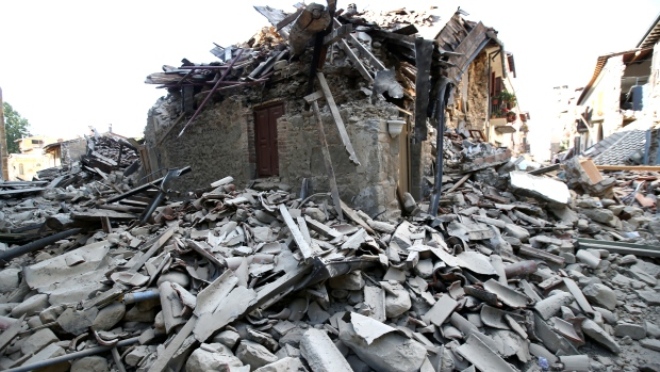
Thursday August 25, 2016
Another aftershock struck at 5:40 a.m. local time Thursday, with a magnitude of 4.7

A collapsed house is seen following an earthquake in Amatrice, central Italy, on Wednesday. (Stefano Rellandini/Reuters)
The number of people killed in the earthquake that devastated parts of central Italy on Wednesday rose to 247 on Thursday morning, regional and national officials said.
Most of the dead — 190 — were in Amatrice and Accumuli and their nearby hamlets.
And many residents of the region have been jolted awake by a strong aftershock, which struck at about 5:40 a.m. local time Thursday.
The U.S. Geological Survey put its magnitude at 4.7 with the epicentre about 7 kilometres east of Norcia, with a relatively shallow depth of 10 kilometres.
Even with the raised death toll, the number of dead and missing is still uncertain given the thousands of vacationers in the area for summer's final days.
The magnitude 6.2 quake struck at 3:36 a.m. on Wednesday and was felt across a broad swath of central Italy, including Rome, where residents woke to a long swaying followed by aftershocks. The temblor shook the Lazio region and Umbria and Le Marche on the Adriatic coast, a highly seismic area that has witnessed major quakes in the past and continued to shake early Thursday with aftershocks.
Dozens of people were pulled out alive by rescue teams and volunteers that poured in from around Italy.
In the evening, about 17 hours after the quake struck, firefighters pulled a 10-year-old girl alive from the rubble in Pescara del Tronto.
1 search focuses on hotel
Dawn broke over the rolling hills of central Lazio and Le Marche regions after a night of uninterrupted search efforts. Aided by sniffer dogs, firefighters and rescue crews using their bare hands pulled chunks of cement, rock and metal apart from mounds of rubble where homes once stood searching for signs of life.
One area of focus was the Hotel Roma in Amatrice, famous for the Amatriciana bacon and tomato pasta sauce that brings food lovers to this medieval hilltop town each August for its food festival.
Amatrice's mayor had initially said 70 guests were in the crumbled hotel ahead of this weekend's festival, but rescue workers later halved that estimate after the owner said most guests managed to escape.
Firefighters' spokesman Luca Cari said that one body had been pulled out of the hotel rubble just before dawn but that the search continued there and elsewhere, even as aftershocks rattled the area a day after the initial quake.
"We're still in a phase that allows us to hope we'll find people alive," Cari said, noting that in the 2009 earthquake in nearby L'Aquila a survivor was pulled out after 72 hours.
Worst affected by the quake were the tiny towns of Amatrice and Accumoli near Rieti, 100 kilometres northeast of Rome, and Pescara del Tronto, 25 kilometres further east.
The civil protection agency set up tent cities around the affected towns to accommodate the homeless. In Amatrice, many elderly and children spent the night inside a local sports facility.
Many buildings not built to withstand quakes
As the search effort continued, the soul-searching began once again as Italy confronted the effects of having the highest seismic hazard in Western Europe, some of it in its most picturesque medieval villages, and anti-seismic building codes that aren't applied to old buildings and often aren't respected when new ones are built.
"In a country where in the past 40 years there have been at least eight devastating earthquakes ... the only lesson we have learned is to save lives after the fact," columnist Sergio Rizzo wrote in Thursday's Corriere della Sera. "We are far behind in the other lessons."
Experts estimate that 70 per cent of Italy's buildings aren't built to anti-seismic standards. After every major quake, proposals are made to improve, but they often languish in Italy's thick bureaucracy, funding shortages and the huge scope of trying to secure thousands of ancient towns and newer structures built before codes were passed or after the codes were in effect but in violation of them.
In recent quakes, some of these more modern buildings have been the deadliest: the university dormitory that collapsed in the 2009 L'Aquila quake, killing 11 students; the elementary school that crumbled in San Giuliano di Puglia in 2002, killing 26 children — the town's entire first-grade class. In some cases, the anti-seismic building standards have been part of the problem, including using reinforced cement for roofs that are then too heavy for weak walls when quakes strike.
Premier Matteo Renzi, visiting the quake-affected zone Wednesday, promised to rebuild "and guarantee a reconstruction that will allow residents to live in these communities, to relaunch these beautiful towns that have a wonderful past that will never end."